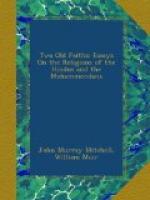[Sidenote: The hymns are strongly religious. They are a selection. Pre-eminently sacerdotal. Present the religious thought of the ancient Hindus.] As soon as we begin to study the hymns of the Veda we are struck by their strongly religious character. Tacitly assuming that the book contains the whole of the early literature of India, many writers have expressed themselves in strong terms regarding the primitive Hindus as religious above all other races. But as we read on we become convinced that these poems are a selection, rather than a collection, of the literature; and the conviction grows that the selection has been made by priestly hands for priestly purposes. An acute critic has affirmed that the Vedic poems are “pre-eminently sacerdotal, and in no sense popular."[1] We can thus explain a pervading characteristic of the book which has taken most readers by surprise. There is a want of simplicity in the Veda. It is often most elaborate, artificial, overrefined—one might even say, affected. How could these be the thoughts, or those the expressions, of the imperfectly civilized shepherds of the Panjab? But if it be only a hymn-book, with its materials arranged for liturgical purposes, the difficulty vanishes.[2] We shall accordingly take it for granted that the Veda presents only the religious thought of the ancient Hindus—and not the whole of the religious thought, but only that of a very influential portion of the race. With all the qualifications now stated, the Veda must retain a position of high importance for all who study Indian thought and life. The religious stamp which the compilers of the Veda impressed so widely and so deeply has not been obliterated in the course of thirty centuries.
[Sidenote: Their religion is Nature-worship.] The prevailing aspect of the religion presented in the Vedic hymns may be broadly designated as Nature-worship.
[Sidenote: Physical phenomena in India. Their effect on the religion.] All physical phenomena in India are invested with a grandeur which they do not possess in northern or even southern Europe. Sunlight, moonlight, starlight, the clouds purpled with the beam of morning or flaming in the west like fiery chariots of heaven; to behold these things in their full magnificence one ought to see them in the East. Even so the sterner phenomena of nature—whirlwind and tempest, lightning and thunder, flood and storm-wave, plague, pestilence, and famine; all of these oftentimes assume in the East a character of awful majesty before which man cowers in helplessness and despair. The conceptions and feelings hence arising have from the beginning powerfully affected the religion of the Hindus. Every-where we can trace the impress of the grander manifestations of nature—the impress of their beneficence, their beauty, their might, their mystery, or their terribleness.




